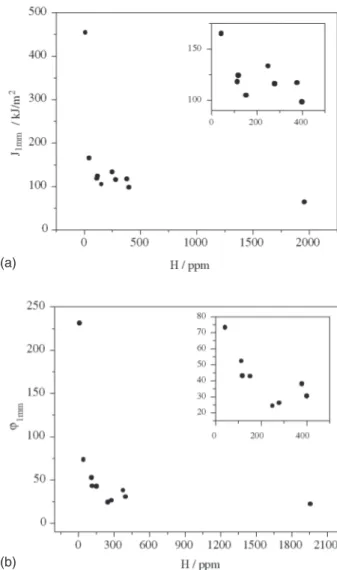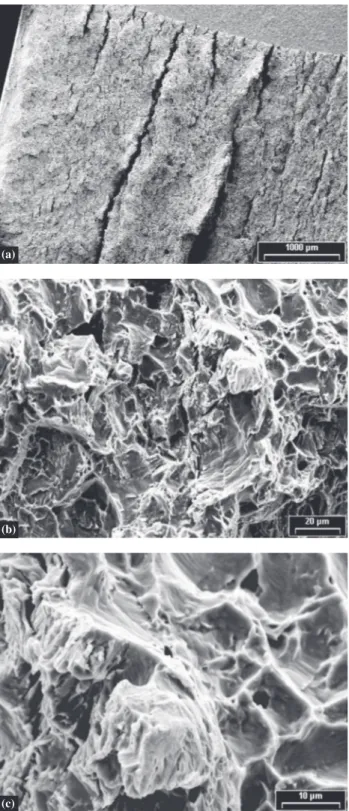Mechanical Properties Degradation at Room Temperature
in ZRY-4 by Hydrogen Brittleness
G. Bertolinoa, G. Meyera/c, J. Perez Ipiñab/c* a Centro Atómico Bariloche, Instituto Balseiro, CNEA,
Bustillo 9500, (8400) S.C. de Bariloche b Universidad Nacional del Comahue,
Buenos Aires 1400, (8300) Neuquén c CONICET
Received: August 28, 2001; Revised: April 14, 2002
A hot rolled Zircaloy-4 alloy, annealed with a final cold rolling, presenting rounded grains, was studied. Hydrogen cathodic charge with a homogenization heat treatment was used to pre-charge the specimens with different hydrogen contents. Hydrogen embrittlement susceptibility analysis was held using J integral and J-R curve results from CT specimens (compact tension specimens) tested at room temperature. As JIC values showed scatter, toughness was evaluated for ∆a = 1mm. Toughness clearly tended to decrease as hydrogen content increased abruptly for low H contents and gradually for high contents. A few specimens with high hydrogen content failed in brittle mode, or presented instability and posterior crack arrest. Fractographic observations showed that, despite the records had presented no signs of brittle fracture, certain specimens showed cleavage-like zones. More cleavage-cleavage-like area percentage was present the higher the hydrogen content was.
Keywords: mechanical properties, delayed hydrogen cracking, zircaloy, hydrides
1. Introduction
It has long been known that Zirconium-based cladding alloys absorb hydrogen as a result of servicing in a reactor environment. Hydrogen can be absorbed from different potential sources: from hydrogen cathodically generated as a result of the corrosion of the cladding by the primary side water coolant, from hydrogen gas dissolved in the primary side coolants in pressurized water reactors, and from hy-drogen released by corrosion of gases or vapors containing hydrogen in the internal plenum region of the rods. In the last years much attention has been devoted to the degrada-tion of the mechanical properties of zirconium-based al-loys both by hydrogen embrittlement and irradiation hard-ening.
At normal reactor operating temperatures hydrogen has limited solubility in the zirconium lattice and mostly pre-cipitates out of the solid solution as Zirconium hydride (ZrH). ZrH precipitation embrittles the zirconium alloy, thus reducing both ductility and fracture toughness. Hydrogen embrittlement is considered as one of the main failure mechanisms in the nuclear reactor structural elements
be-cause hydrogen rich environment plus physical conditions favor hydrogen absorption1. Delayed hydride cracking (DHC) in zirconium-based alloys has been known as a po-tential failure mechanism in CANDU reactor pressure tubes2. Because of the stress field dominating the crack tip zone, it was observed that hydrogen diffuses into this area and pre-cipitates as hydride, preferently with a direction perpendicu-lar to the perpendicu-largest tension stress component. It was also ob-served that a crack can be generated at some typical defects and the subsequent growth mechanism is due to hydride formation ahead the crack tip -crack grows through either them or the matrix interface- generating new hydride pre-cipitates and so on2.
The aim of this work was to study the variation of frac-ture toughness of a zirconium-based alloy, Zircaloy-4, at different hydrogen contents.
2. Material and Method
Material
The study was carried out using a Zircaloy-4 alloy (Zry-4) 6 mm-thick slab, hot rolled and annealed with final cold
*e-mail: pipina@uncoma.edu.ar
993.
Specimens were fatigue pre-cracked up to a/W ratios (crack length to specimen width ratios) between 0.45 and 0.55, in accordance to standard procedures.
Specimens surfaces were mechanically polished and then etched with a 25% lactic acid, 25% water, 46% HNO3 and 4% HF solution before the hydrogen charge. The cathodic charge was performed in a 0.1 M KOH solution with a 0.5 A current. Finally specimens were heat-treated during 6 hours in argon or hydrogen atmosphere at 450 °C; and then cooled inside the furnace, slowly down to room temperature.
Testing method
The tests were carried out using a servohydraulic
ma-ing the ASTM E 1820-99 standard. The data were rotation-corrected using the formulation introduced in ref. (5). The final crack length was marked by fatigue postcracking be-cause the conventional method used in steels, i.e. heat tint-ing, works by surface oxidation, this making it inappropri-ate for posterior SEM observation.
J-R curves were obtained in all cases where stable crack growth was present. Values of J at crack growth initiation, JIC, for 1mm of stable crack growth, J1mm, and the curve slope at this point, ϕ1mm, were determined. For those speci-mens that fractured in brittle mode, the corresponding JC values were calculated.
Hydrogen content was measured in all specimens after tests by means of a LECO Hydrogen Determinator equip-ment, in which a sample is melt inside a EF-400 Electrode Furnace and then gases are filtered into a RH-404 unit to measure their hydrogen content.
Fracture surfaces were observed by means of optic and electronic microscopes.
3. Results
Figure 2 shows two typical load-displacement records that were obtained during the tests. The first one is a con-ventional record, similar to those obtained for homogene-ous materials presenting ductile behavior; the second one shows sudden load drops and abrupt changes in the slopes with no complete load recovery.
J-R curves are depicted in Fig. 3. Some specimens ini-tially presented an apparent negative crack growth, Fig. 3a, located in the blunting zone. For these cases the correction proposed in ref. (4) was used.
Due to the fact that JIC values obtained showed an im-portant scatter, Fig. 4, the J and ϕ values for 1 mm stable crack growth were taken as comparative values, Figure 5. Table 2 shows the experimental J and ϕ values obtained for each hydrogen content.
Figure 6 shows a fracture surface observed in a scan-ning electron microscope, corresponding to a specimen con-taining 250 ppm of hydrogen. A mixed mode of fracture Table 1. Mechanical Properties at room temperature.
Property Longitudinal Transversal
σUTS [MPa] 522 510
σy [MPa] 365 460
Elongation % 27.8 28.6
Figure 3. a) Negative crack growth correction on a J-R curve. b) Effects of the hydrogen content on the J-R curves.
Figure 2. Load – load line displacement records obtained in speci-mens with different hydrogen contents.
Figure 4. JIC as a function of hydrogen content. Table 2. JIC, J1mm, JC and ϕ1mm values obtained at different
hydro-gen contents.
H JIC J1mm JC ϕ1mm
[ppm] [kJ/m2] [kJ/m2] [kJ/m2] [kJ/(m2 mm]
290 Brittle Fracture - 12.6
-119 80 123 - 42.9
43 100 164 - 73.2
114 67 118 - 52.2
153 62 104 - 42.7
273 108 133 - 24.2
400 50 98 - 30.5
150 88 115 - 26.1
378 78 145 - 37.9
1947 45 - 51.9
-1960 39 64 - 23.0
10 378 453 - 231.1
(a)
(b) (a)
can be observed showing brittle mode zones as well as microvoids coalescence regions. Figure 7 corresponds to a specimen that fractured in brittle mode.
4. Discussion
The cathodic charge proved a convenient method for specimen hydrogen precharge. A thin hydride layer precipi-tated onto its surface. The hydrogen diffused further to the interior when heat treated, giving a homogenized distribu-tion inside the whole specimen. Opposite to the gaseous charge technique, this one did not destroy specimens sur-face.
Most tests presented ductile behavior, although a few specimens with high hydrogen content failed in brittle mode, or presented instability and posterior crack arrest.
Figure 6. Fracture surface observation by SEM, showing a) mixed mode of fracture, b) a magnified zone of a.
Figure 5. Variation of a) J1mm and b) ϕ1mm with the hydrogen con-tent.
Irregularities observed in the blunting line zone, i.e. ap-parent negative crack growth, are likely to be attributed to the specimen reduced thickness (6 mm). Although this ef-fect is well known and has been several times reported2,6, the frequency of occurrence during this experience was high, and the correction applied did not give satisfactory results, Fig. 4. This will be the subject of future work.
As it was previously described, results were analyzed for 1mm of stable crack growth in order to reduce the influ-ence of the blunting zone. Both parameters, J and the R-curve slope, showed a clear tendency to decrease as hydro-gen content increased, Fig. 5. The toughness drop was abrupt for low H contents, below 250 ppm, turning gradual for higher concentrations.
Tests for the highest H contents (>1900 ppm) presented brittle fracture or unstable crack growth with subsequent crack arrest (pop-in). In the first case toughness was
char-(a)
(b)
(a)
Figure 7. Fracture surface observation by SEM, a) stable crack growth and longitudinal cracks, b) beginning of stable crack growth, c) zoom of b.
acterized by J at instability point, JC. The fact that pop-in occurred after some stable crack growth allowed initiation values be obtained. Intead, in the case of the specimen that presented brittle fracture, this was close after the initiation, giving a JC value higher than JIC, which does not mean a higher toughness.
Fractographic observations on some surfaces corre-sponding to specimens that presented neither brittle frac-ture nor instability during the tests showed areas that looked like cleavage mechanism. The proportion of apparent cleavage zones was higher the higher the hydrogen con-tent.
5. Conclusions
Specimens preparation techniques proved satisfactory. Most tests presented ductile behavior, although a few ones with high hydrogen content failed in brittle mode, or pre-sented instability and posterior crack arrest. JIC values showed an important scatter in spite of the negative crack growth correction done. When results were analyzed for
∆a = 1mm values (J1mm and ϕ1mm), toughness clearly tended to decrease as hydrogen content increased. Toughness drop was abrupt for low H contents while gradual for high con-tents. Fractographic observations presented more cleav-age-like area percentage the higher the hydrogen content was. Despite the records presented no signs of brittle frac-ture, certain specimens showed cleavage-like zones.
References
1. Davies P.H.; Shewfelt R.S.W. Zirconium in the Nuclear Industry, 11° International Symposium, ASTM STP 1295, p. 492-517, 1996,
2. Efsing P.; Pettersson K. Zirconium in the Nuclear Indus-try, 11° International Symposium, ASTM STP 1295, p. 394-404, 1996,
3. ASTM E 1820-99. Annual Book of ASTM Standards, v. 03.01, p. 972-1005, 1999.
4. Underwood J.H.; Troiano E.J.; Abbott R.T. Fracture Mechanics: 24° Volume, ASTM STP 1207, Philadelphia, p. 410-421, 1994.
5. Perez Ipiña J.E. Engineering Fracture Mechanics, v. 36, n. 5, p. 797-804, 1990.
6. Dubey J.S.; Wadekar S.L.; Singh R.N.; Sinha T.K. Chakravartty J.K., Journal of Nuclear Materials, v. 264, p. 20-28, 1999.
(a)
(b)



